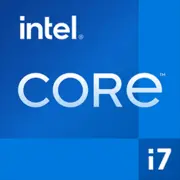Intel Core i7-11700F

Intel Core i7-11700F in 2025: Is it Worth Picking Up This "Veteran" of Rocket Lake?
Despite the release of new generations of processors, the Intel Core i7-11700F remains a popular choice for budget builds and upgrading older systems. Let's explore what this 8-core chip is capable of in 2025, who it suits, and what pitfalls to consider.
1. Key Specifications: Architecture and Features
Codename and Process Technology
The processor was launched in 2021 on the Rocket Lake-S architecture, which was the last for Intel on the 14nm process. Despite its "age," the 14nm technology achieved stability and reduced manufacturing costs, which is reflected in the final price of the chip.
Performance
- 8 cores, 16 threads with a base frequency of 2.5 GHz and a turbo boost up to 4.9 GHz.
- 16 MB L3 cache — sufficient for most gaming and work tasks.
- In the Geekbench 6 test (2025): 2144 points (single-core), 8162 points (multi-core). For comparison, the Ryzen 5 7600X scores about 2500/11500 points but is priced $100 higher.
Key Features
- Supports PCIe 4.0 (20 lanes) — relevant for modern SSDs and graphics cards.
- Integrated memory controller for DDR4-3200.
- Intel Turbo Boost Max 3.0 and Hyper-Threading technologies.
2. Compatible Motherboards
LGA 1200 Socket — this limits motherboard choices to models released in 2020-2021. Main chipsets include:
- Z590 (high-end): unlocked multiplier, PCIe 4.0 support, RAM overclocking. Example: ASUS ROG Strix Z590-E ($220-250 in 2025).
- B560 (mid-range): PCIe 4.0 only for the graphics card, limited memory overclocking. Example: MSI B560M Pro-VDH ($130-150).
- H510 (budget): no PCIe 4.0, maximum 64 GB RAM. Suitable for office builds.
Important! When choosing a motherboard, check the list of supported processors on the manufacturer’s website. Updating the BIOS may be required for older revisions for the i7-11700F.
3. Memory Support
The processor only works with DDR4 (up to 3200 MHz in Gear 1 mode). In 2025, this is already an outdated standard, but DDR4 modules remain cheaper than DDR5:
- 32 GB DDR4-3200 (2×16 GB) — $70-90.
- 32 GB DDR5-6000 — $120-150.
Tip: Use a dual-channel configuration (2 or 4 modules). 16 GB is sufficient for gaming; 32 GB for work tasks.
4. Power Supply Recommendations
The processor has a nominal TDP of 65W, but under load, consumption can reach 150-180W (due to the 14nm process characteristics).
- For a system with a graphics card like the RTX 4060 or RX 7600 XT, choose a PSU of at least 550W.
- Examples: Corsair CX550M (80+ Bronze, $65), Seasonic Focus GX-550 (80+ Gold, $90).
Caution! Cheap PSUs without an 80+ certification may struggle with peak loads, causing throttling.
5. Pros and Cons
Strengths:
- High single-thread performance — relevant for gaming and applications like Photoshop.
- Low price — $180-220 (new, April 2025).
- PCIe 4.0 support — compatible with modern SSDs (e.g., Samsung 980 Pro).
Weaknesses:
- High heat output under load — a good cooler is essential.
- No support for DDR5 and PCIe 5.0 — limits future upgrades.
- Falls short against new i5-13400F in multi-threaded tasks.
6. Use Cases
Gaming
The processor handles any 2025 titles paired with a graphics card like the RTX 4070:
- Cyberpunk 2077: Ultra, 1080p — 85-90 FPS (without ray tracing).
- Alan Wake 2: High, 1440p — 60-65 FPS (with DLSS).
Work Tasks
- Video editing in DaVinci Resolve: rendering a 4K video takes 12-15 minutes.
- 3D modeling in Blender: on par with the Ryzen 7 5700X.
Multimedia
Streaming (OBS + NVIDIA NVENC) and photo editing — no lag even with background tasks.
7. Comparison with Competitors
- Ryzen 7 5700X ($220): comparable multi-thread performance, but the i7-11700F excels in gaming due to higher clock speeds.
- Intel Core i5-13400F ($240): 10 cores (6P+4E), DDR5 support, but 20% more expensive.
- Ryzen 5 7600 ($280): 15-25% faster but requires an expensive AM5 motherboard and DDR5.
8. Practical Assembly Tips
- Cooler: At least a DeepCool AK400 ($35) or Arctic Freezer 34 eSports. The stock Intel cooler is not recommended — it’s noisy and overheats.
- Case: Choose models with good ventilation (e.g., NZXT H5 Flow).
- SSD: Use NVMe with PCIe 4.0 (WD Black SN850X, 1TB — $90).
- Upgrade: If you already have an LGA 1200 motherboard, the i7-11700F will be an excellent upgrade from an i3-10100.
9. Final Conclusion: Who Is This Processor For?
The Intel Core i7-11700F in 2025 is suitable for:
1. Gamers, building a PC with a graphics card up to the RTX 4070 Ti.
2. Owners of older systems on LGA 1200, looking to upgrade without changing the motherboard.
3. Budget workstations — for rendering, editing, and programming.
Why this one? The price-to-performance ratio remains attractive, especially if you’re not ready to overpay for DDR5 and PCIe 5.0. However, for an entirely new build, it’s better to consider the i5-13400F or Ryzen 5 7600 — they offer more prospects for future upgrades.
Basic
CPU Specifications
Memory Specifications
GPU Specifications
Miscellaneous
Benchmarks
Compared to Other CPU
Share in social media
Or Link To Us
<a href="https://cputronic.com/en/cpu/intel-core-i7-11700f" target="_blank">Intel Core i7-11700F</a>